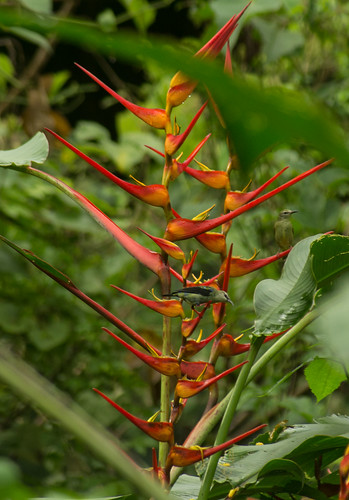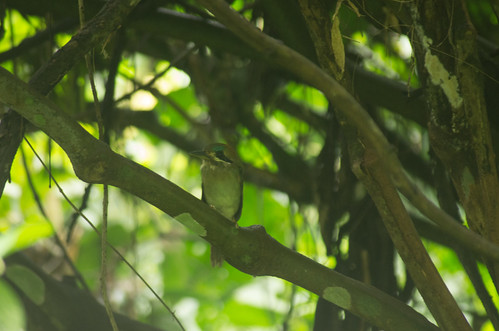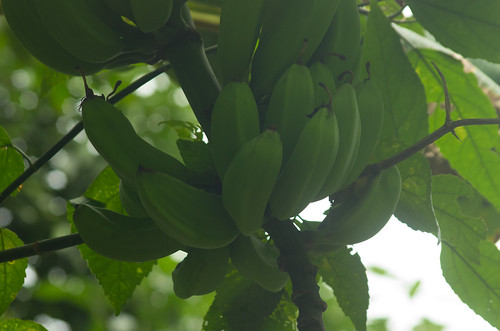(apologies for the slight delay in getting the posts out to you, internet access has been intermittent, but we're having an amazing time. We'll keep the posts going up as and when we get the chance, but know the delay is due to technological challenges and overly full days rather than anything more sinister)
Needless to say, we slept incredibly well that night, after a great meal and our hike.
The next morning, we were up and at it again with our trusty guide Elicier for more birds. This time we headed over to Valle Chiquito, just over the next smallest mountain to El Valle. A little further out than we had yet been, but it was worth the small drive. Almost immediately after getting out of the van we started spotting birds.
A red legged honeycreeper in the heliconia
And a toddy motmot! My photography friends I hope will forgive the less than stellar technical execution.
And it wasn't just birds we spotted (as per usual)
If you look towards the centre of the photo, the thing that looks like a rather ratty looking piece of brown shag carpet, that's a sleeping two-toed sloth! Which, with the two toed sloth we saw the first day, completes the set of sloths that inhabit Panama. Quite cool. The two-toed sloths are nocturnal, so to see one any more active than that would be highly unlikely.
Wild bananas - our first view, and certainly not the last. Apparently, there is no way to tell a banana plant from a plantain plant until they start to fruit.
Whooping motmot aka the blue crested motmot - and this with the two motmots we saw on our first day, we have see the complete set of four that live in this region. Pretty exciting no? We sat and watched this little guy for quite a while. He had a way of swinging his tail almost exactly like a clock pendulum. Not entirely sure why, but it was an interesting behavioural tick.
a termite nest - about the size of two basketballs put together. Another first that is not to be the last.
Looking back across the valley where we spent our day. Beautiful. As we were packing up to head back to the lodge, Elicier's ears all of a sudden perked up and he was over to the side of the road with the scope, saying he could hear tamarind monkeys in the distance. And sure enough! He got one in scope just long enough for me to see it's back and tail disappear into the foliage. We soon learned what had them so agitated when a grey lined hawk swooped down and across the valley from where they were over to us. My camera by this point was in the car, but Stephen still had his out, so look out for when he posts his photos! Also, by this point it was becoming very obvious that Stephen is developing quite the knack for wildlife photography. Should bode well for the remainder of our trip!
After so much late morning excitement, it was back to the lodge for another tasty lunch. A quick break and then we actually headed into town for the afternoon. The goal was to check out the rather famous Amphibian Centre and then hit the hot springs.
The Amphibian Centre is being run by the Smithsonian Instutute and is partnered with a number of world class research centres. It's known primarily for it's conservation efforts for the Panamanian Golden Frog, which may or may not be extinct in the wild. It also does research and has a breeding programme for many other rare frogs. Seeing as frogs are either a)tiny or b)mostly nocturnal we figured this would be the better place to see some of Panama's more elusive yet famous denizens.
As a result we were expecting rather more than what there was. It's housed in what can only be very loosely called a zoo, and a rather sad one at that. But we made a beeline for the Amphibian Centre, which is a small greenish building towards the back of the site. Coming in was a strong smell of bleach (considering most of the frogs on display are threatened at least in part due to the chytrid fungus, it shouldn't have been a surprise) and then a large glassed in habitat in the centre, with the famous Panamanian Golden Tree Frog and then smaller terrariums around the perimeter with other very interesting denizens. Elicier again turned out the be a font of knowledge, which was great considering that there wasn't really much in terms of information posted.
The harlequin frog.
The smooth sided toad - apparently this was the one that we spotted along the trail on our way down the day before. Nice to see one in slightly better conditions!
"Green" and Black poison dart frogs. Mate, she's not interested.
And the star of the show - the Panamanian golden tree frog. Apparently, they do come in other colouration than all gold/yellow, like this one.
It was great to see the frogs close up, but the lack of information about the conservation efforts or more details on the habits & habitats of these beautiful creatures was very disappointing. It also meant we were finished with as much as there was to see after about 30 minutes.
So then it was off to the hot springs for a good soak and to let some of what we have seen so far on our trip soak in per se. It was a fairly primitive set-up but a nice experience regardless. We got to chatting with a few of the others there, travellers like us from various parts of the world, making do in our little Spanish and their little English.
After a good soak it was back to the lodge for an early supper and quiet evening (it was our last full day, so alas we needed time to pack). The next day would take us to a very different environment indeed. Needless to say, we had an amazing time at Canopy Lodge and would highly recommend a stay for at least a few days if you find yourself in Panama.
(as always, these are only a selection of the pictures I took on the day. For the rest of the set, head over to my flickr page. You can also see Stephen's pictures too here.)












No comments:
Post a Comment